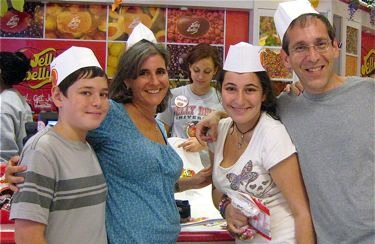I remember exactly when the pandemic started: March 11, 2020. That’s the date the World Health Organization upgraded COVID-19 from “public health emergency” to the formal status of “pandemic.”

In Israel, it was actually several days earlier. “We are in the midst of a global pandemic, even if this has not been declared officially,” Prime Minister Benjamin Netanyahu told his cabinet on March 8.
While the beginning may be a matter of public record, when this pandemic ends will be different for every individual.
“Pandemics typically have two types of endings,” writes Gina Kolata in The New York Times. “The medical, which occurs when the incidence and death rates plummet, and the social, when the epidemic of fear about the disease wanes.”
“When people ask, ‘When will this end?,’ they are asking about the social ending,” Dr. Jeremy Greene, a historian of medicine at Johns Hopkins, tells Kolata.
In other words, “an end can occur not because a disease has been vanquished but because people grow tired of panic mode and learn to live with a disease,” Kolata sums up. “Many questions about the so-called end are determined not by medical and public health data but by sociopolitical processes.”
That pretty well describes what happened the last week in May in Israel as restaurants, synagogues, schools and stores re-opened at a dizzying pace.
We’ve seen pandemics of fear abate before. Remember the Hong Kong flu of 1968, that killed a million people worldwide, including 100,000 in the United States? You don’t? That’s because whatever fear accompanied that flu (and in a pre-social media age, it wasn’t nearly as much as we see today with COVID-19) dissipated. The virus, by the way, didn’t disappear; it still circulates as a seasonal flu to this day.
My personal pandemic of fear around corona came to a tentative end on the Jewish holiday of Shauvot. That was the day that we allowed our children (those who didn’t already live with us) to come into our home for the first time in more than two months.
We didn’t open up because I was entirely OK with it – on the contrary, I am still quite concerned about catching the virus, even more so now with the alarming spike in infections over the last week.
But I was exhausted shouldering the burden of being the sole gatekeeper for our family, the one on whom it constantly fell to decide – given that my cancer makes me the person most at risk in our unit – what we should wear (mask or gloves?), who can come in, when we can go meet with friends again, under what conditions.
I’ve written before about balancing risk and uncertainty. Every day we know more about this virus.
Robin Schoenthaler, an oncologist in Boston who has gathered a following for writing plainly about the pandemic, describes it like this: People talking normally – low risk. People shouting or singing – higher risk. Wearing a mask – low risk. Standing more than six feet away – low risk. Spending less than 15 minutes together – low risk. Touching packages and groceries: very low risk.
That’s “not no risk,” stresses Schoenthaler, “but lower risk.”
We are now in the second phase of Tomas Pueyo’s virally shared article, “The Hammer and the Dance,” where, after the pounding of the initial lockdown, we dance with precautions – mini-closures, contact tracing and quarantines when cases spike, as they inevitably will – until the virus is gone or a vaccine arrives.
Still, it was bewildering at first. Haaretz’s Ofri Ilany describes the post lockdown period as “reverse culture shock … a characteristic of people who have spent a significant amount of time in a different cultural milieu, on their return to their regular environment.”
With reverse culture shock comes disorientation. In an interview with the newspaper Neue Züricher Zeitung, Swiss psychiatrist Josef Hättenschwiler notes that during lockdown, “everyday worries and hardships wereperceived as negligible in view of the immediate physical threat.” As we open up again, though, our anxieties return, whether that’s exams, projects and deadlines we may secretly have hoped might be delayed or scrapped entirely because of the crisis, or the hard choices of whether, when and how to see family and friends again.
As the numbers shot up over the Shavuot holiday – mind you, the news broke after we’d welcomed our children home – outgoing director general of the Health Ministry Moshe Bar Siman Tov attributed the growing number of cases to an “atmosphere of euphoria and complacency.”
Dina Kraft has another explanation.
“Israelis are good foot soldiers when ‘under attack,’ willing to listen to public safety orders like entering bomb shelters during times of war,” she writes for NBC News. Where they have trouble is “dealing with anything in the middle when it comes to a crisis.”
Kraft wonders whether Israel’s fast-moving return from isolation is an example of “the smart, nimble, Israeli chutzpah style” – the one manifested by the Start-up Nation – or if what we’re experiencing is more of a “sloppy rush that leaves Israelis more vulnerable than necessary.”
“This is completely in our control,” Bar Siman-Tov emphasized. “If we are meticulous about the rules, we’ll succeed in blocking the spreading of infection.”
In that respect, maybe the uptick is a good thing – a much needed wake up call.
But it also calls into question: did one of the pandemics – the pandemic of fear – even end last week? I’m not so sure anymore. Maybe, like the medical pandemic, it too goes in waves, destined to rise and fall for many months to come.
I first wrote about pandemic beginnings and endings at The Jerusalem Post.
Face mask image from https://www.nursetogether.com/ / CC BY-SA (https://creativecommons.org/licenses/by-sa/4.0)

